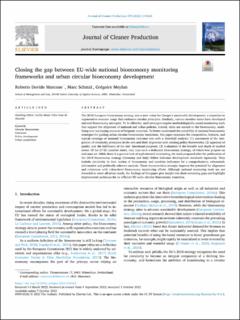Please use this identifier to cite or link to this item:
https://doi.org/10.21256/zhaw-26450Full metadata record
| DC Field | Value | Language |
|---|---|---|
| dc.contributor.author | Marcone, Roberto Davide | - |
| dc.contributor.author | Schmid, Marc | - |
| dc.contributor.author | Meylan, Grégoire | - |
| dc.date.accessioned | 2022-12-16T14:08:45Z | - |
| dc.date.available | 2022-12-16T14:08:45Z | - |
| dc.date.issued | 2022 | - |
| dc.identifier.issn | 0959-6526 | de_CH |
| dc.identifier.uri | https://digitalcollection.zhaw.ch/handle/11475/26450 | - |
| dc.description.abstract | The 2018 European bioeconomy strategy sets a new vision for Europe's sustainable development: a transition to regenerative resource usage that embraces circular principles. Similarly, various member states have developed national bioeconomy strategies. To be effective, such strategies require methodologically sound monitoring tools that support the alignment of national and urban policies. Indeed, cities are central to the bioeconomy, mobilizing ever increasing amounts of biogenic materials. To better understand the suitability of national bioeconomy strategies for guiding urban circular bioeconomy transitions, this paper examines the composition, features, and topical coverage of national bioeconomy indicator sets with a threefold analysis: (1) assessment of the integration of circularity principles in the sets and their alignment with existing policy frameworks; (2) appraisal of quality and the fulfillment of the sets' functional purposes; (3) evaluation of the breadth and depth of tackled issues. Of the 27 EU member states, only nine have a dedicated bioeconomy strategy, of which four propose an indicator set. While there is a general lack of sophisticated monitoring, the tools proposed after the publication of the 2018 bioeconomy strategy (Germany and Italy) follow indicator development standards rigorously. They include circularity in their notion of bioeconomy and combine indicators for a comprehensive, substantial, informative and politically relevant analysis. These characteristics strongly improve the potential for alignment and coherence with urban-level bioeconomy monitoring efforts. Although national measuring tools are not intended to cover all urban needs, the findings of this paper give insight into their remaining gaps and highlight improvement pathways for an efficient EU-wide circular bioeconomy transition. | de_CH |
| dc.language.iso | en | de_CH |
| dc.publisher | Elsevier | de_CH |
| dc.relation.ispartof | Journal of Cleaner Production | de_CH |
| dc.rights | https://creativecommons.org/licenses/by/4.0/ | de_CH |
| dc.subject | Circular bioeconomy | de_CH |
| dc.subject | Indicator | de_CH |
| dc.subject | Policy development | de_CH |
| dc.subject | Urban metabolism | de_CH |
| dc.subject.ddc | 338.927: Umweltökonomie und nachhaltige Entwicklung | de_CH |
| dc.title | Closing the gap between EU-wide national bioeconomy monitoring frameworks and urban circular bioeconomy development | de_CH |
| dc.type | Beitrag in wissenschaftlicher Zeitschrift | de_CH |
| dcterms.type | Text | de_CH |
| zhaw.departement | School of Management and Law | de_CH |
| dc.identifier.doi | 10.1016/j.jclepro.2022.134563 | de_CH |
| dc.identifier.doi | 10.21256/zhaw-26450 | - |
| zhaw.funding.eu | No | de_CH |
| zhaw.issue | 134563 | de_CH |
| zhaw.originated.zhaw | Yes | de_CH |
| zhaw.publication.status | publishedVersion | de_CH |
| zhaw.volume | 379 | de_CH |
| zhaw.publication.review | Peer review (Publikation) | de_CH |
| zhaw.webfeed | W: Spitzenpublikation | de_CH |
| zhaw.author.additional | No | de_CH |
| zhaw.display.portrait | Yes | de_CH |
| Appears in collections: | Publikationen School of Management and Law | |
Files in This Item:
| File | Description | Size | Format | |
|---|---|---|---|---|
| 2022_Marcone-etal_Bioeconomy-monitoring-development-gap.pdf | 3.82 MB | Adobe PDF |  View/Open |
Show simple item record
Marcone, R. D., Schmid, M., & Meylan, G. (2022). Closing the gap between EU-wide national bioeconomy monitoring frameworks and urban circular bioeconomy development. Journal of Cleaner Production, 379(134563). https://doi.org/10.1016/j.jclepro.2022.134563
Marcone, R.D., Schmid, M. and Meylan, G. (2022) ‘Closing the gap between EU-wide national bioeconomy monitoring frameworks and urban circular bioeconomy development’, Journal of Cleaner Production, 379(134563). Available at: https://doi.org/10.1016/j.jclepro.2022.134563.
R. D. Marcone, M. Schmid, and G. Meylan, “Closing the gap between EU-wide national bioeconomy monitoring frameworks and urban circular bioeconomy development,” Journal of Cleaner Production, vol. 379, no. 134563, 2022, doi: 10.1016/j.jclepro.2022.134563.
MARCONE, Roberto Davide, Marc SCHMID und Grégoire MEYLAN, 2022. Closing the gap between EU-wide national bioeconomy monitoring frameworks and urban circular bioeconomy development. Journal of Cleaner Production. 2022. Bd. 379, Nr. 134563. DOI 10.1016/j.jclepro.2022.134563
Marcone, Roberto Davide, Marc Schmid, and Grégoire Meylan. 2022. “Closing the Gap between EU-Wide National Bioeconomy Monitoring Frameworks and Urban Circular Bioeconomy Development.” Journal of Cleaner Production 379 (134563). https://doi.org/10.1016/j.jclepro.2022.134563.
Marcone, Roberto Davide, et al. “Closing the Gap between EU-Wide National Bioeconomy Monitoring Frameworks and Urban Circular Bioeconomy Development.” Journal of Cleaner Production, vol. 379, no. 134563, 2022, https://doi.org/10.1016/j.jclepro.2022.134563.
Items in DSpace are protected by copyright, with all rights reserved, unless otherwise indicated.